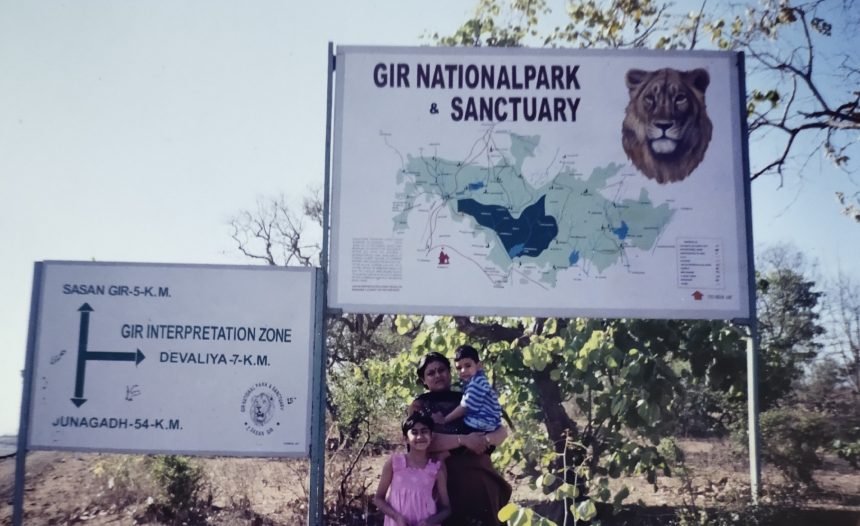Gir Interpretation Center – Devalia: Repository of Asiatic Lions
While lions captivate and rivet our unequivocal attention towards them, their population has been dwindling due to various threats such as habitat loss, human-wildlife conflict, and poaching

By Colonel Satish Singh Lalotra
The lion is an emblem of the dream of absolute power—and, as a wild rather than a domestic animal; he belongs to a world outside the realm of society and culture. These prophetic lines by famous author Charles Hinnat may be true in partial sense only; since the same animal when juxtaposed in the Indian context straddles more than a life size of his forms in the annals of Indian mythology, art, sculpture and last but not the least has left his imprints even in the world famous ‘Lion capital of Ashoka the great at Sarnath, India in 250 BC. Its crowning features are four life-sized lions set back to back on a drum shaped abacus. The Buddhist wheel of the moral law appears in relief below each lion. The lion capital is among the first group of significant stone sculptures to have appeared in South Asia after the end of the ‘Indus valley civilization’ (IVC) 1600 years ago.
The fact that India has taken these Sarnath Lions as its core reflection of values in terms of strength, straightforwardness and ruling the entire cosmos on the back of these twin qualities with words to the effect ‘Satymev Jayate’ goes to prove that some facets of life are non-negotiable. With Lions a perfect personification of the above qualities, can it remain outside the realm of society and culture as enunciated by famous author Charles Hinnat? No it cannot. In fact the society, particularly the Indian society has some of its most intimate and intricate relations closely intertwined with this beast permeating down even to its day to day interactions. The state of Gujarat, more so that of ‘Saurashtra’ region has ‘Gir Asiatic Lion’ as its signature mark of identification the world over.
The date of 10th August 2024 had its sojourn & designated as the ‘World lion day’ which happen to pass a few day back without causing as much a ripple even in our country which is known as the last bastion of Asiatic lion in the world. That should not have been the case. The ‘World lion day’ was initiated by ‘Big cat rescue’, the world’s largest accredited sanctuary dedicated to these big cats. It is a day for people to come together from across the globe to pay tribute to the mighty lion! ‘World lion day’ is an occasion to celebrate the majestic lions that captivate our hearts with their strength, straightforwardness and magnificence as stated above by me. This day was established to bring global attention to the declining number of lions and the urgent need for their conservation.
While lions captivate and rivet our unequivocal attention towards them, their population has been dwindling due to various threats such as habitat loss, human-wildlife conflict, and poaching. This ‘World Lion day’ I was reminded of my impromptu visit two decades back to one of the most enchanting places on earth that has the singular distinction of preserving and also portraying its wildlife wealth in the form of the world famous ‘Asiatic lion’ at ‘Devalia’ which is the ‘Standard –bearer’ of India’s stamp of preservation of the ‘Big cat’. Nestled in the Girforest, the ‘Gir interpretation zone or center’ Devalia (popularly known as Devalia safari park) is a mini version of the large expanse of Gir forest. This 412 hectare safari park has almost all representative wildlife and forests of Gir. The foresight behind the safari park’s conception was to create awareness about the Gir ecosystem’s conservation values and to provide a unique and unforgettable experience to the visitors.
In one of my previous articles on ‘Interpretation centers’ I had laid much emphasis on the need to have such infra for the visitors who could partake in understanding the heritage of a particular area with the help of user-friendly and interactive and often scenographic exhibitions and multimedia programmes. An interpretation center as mentioned in one of my previous write ups in Rising Kashmir paper can be a viable solution for effective communication of heritage information in municipalities and rural areas where resources may not exist to establish a traditional, full-fledged museum and where heritage can be an important factor for tourism development. ‘Devalia’ is one such perfect interpretation center which is doing a yeoman’ job of show casing its animal heritage in terms of the world famous Asiatic lion to the world at large.
In Devalia within a short period of time a visitor can expect to sight Asiatic lions and other wild life in their almost natural habitat. It was in the autumn of 2002 while posted at Dharangadhra in Gujarat ,but coming from my operational area during ‘OP Parakram’ for a brief casual leave that I made the quick decision to visit this Asiatic lion sanctuary located near Junagadh in south Gujarat. The underlying idea to visit this forest sanctuary was to combine my sojourn even with the world famous rock edicts of ‘Ashoka the Great’ located in the world famous Girnar hills and also simultaneously visit the famous Hindu temple of Somnath near Veravel coast of Gujarat. All in one tourist circuit made much sense since these places were separated within 2 to 3 hours of time and space from each other.
Taking a south- westerly route from Dharangdhra to Rajkot I wheeled on to the GJ SH 7 & NH 27 (Gujarat state highway 7 and national highway 27) which was a smooth ride even twenty years back and hit Junagadh by late afternoon the same day a distance of about 250 kilometers. Making Junagadh as my base it was easier for me to reel in and out for these locations without much botheration. I shall not delve upon the rock edicts of Ashoka the great over here, since I have covered them already in this newspaper last year (May 2023) under the heading ‘Girnar rock edicts—India’s westernmost peace imprints’. Coming back to the ‘Devalia interpretation zone or center’ it would not be an exaggeration to state here that a real painstaking work has been undertaken by the Gir forest authorities to not only cater to the pride of Gujarat and India i.e the Asiatic lion’ but even the beauty of Indian leopard has been very imaginatively captured by way of making ‘open moats’ that is not seen anywhere in the interpretation centers attached with the wild life sanctuaries of India.
This unique interpretation at Devalia also boasts of other wildlife such as spotted dear, sambar, blue bulls, black buck, wild boars, Indian golden jackal, endangered and critically endangered species of vultures, jungle cats, and myriad species of birds. As of August 2024, the Asiatic lion population in India was spread over in 10 ( ten) districts of Gujarat with 268 making their presence in Junagadh, 44 lions in Gir Somnath, 174 in Amerli and 37 lions in the coastal region of Bhavnagar. These lions also have made their presence felt in the coastal regions of Gujarat with about 104 living entirely along the west coast of Gujarat. Since these Asiatic lions are an entirely different race from the ones that are found in the savannah jungles of Africa (African lions) where they are thriving at a much faster rate but also vulnerable to poaching, it is the Asiatic lions who are battling their existence against odds ranging from climate change, human interference/ encroachment in their habitats, shortage of space to endless cycles of illnesses that strike them from time to time.
As per the latest IUCN (International union for conservation of nature) report which categorized the Asiatic lions as vulnerable, highlights a significant difference in the risk of decline faced by the African lions and Indian lions. The likelihood of a 33% decline faced by the lion population in Africa is 19 times higher than in India, primarily due to rampant poaching. This is a saving grace for the planners in India and also calls for a quick review of our own ways to check this menace before the fate of African lions becomes a fait -accompli for Asiatic lions too. Few years back a GOI Initiative was undertaken in the form of ‘Asiatic lion reintroduction project’ to provide safeguards to them from extinction in the wild by means of reintroduction. The biggest threat to these Asiatic lions as opposed to their cousins in Africa is the threats of epidemics, natural disasters and anthropogenic factors. This reintroduction project aims to establish a second home to these lions and help an independent growth at the ‘Kuno national park’ in MP. However the proposed translocation has been hotly contested by the state government.
The Asiatic lion is expanding its footprints in newer territories; sightings in Jamnagar district have been confirmed. In just four months, lions have been spotted twice in the Jamjodhpurtaluka. The first sighting was in January this year when a female and a sub-adult lion were seen. Now officials say that a radio-collared sub-adult lioness, estimated to be between 5 to 9 years old, has made the area her new home, preying on Nilgai which are abundant in this area. This indicates that lions are adapting well to the ecosystem. India in any case has taken big strides in lion conservation by way of various steps in the last few years. On 15th august 2020, Project lion’ was launched as a pivotal initiative aimed at securing the future of Asiatic lion through comprehensive, long term conservation efforts. Key components of this project involve habitat improvement, monitoring through advanced technologies like radio collaring, and camera traps and addressing human-wildlife conflict.
The Gujarat forest conservation department plays a crucial role in these conservation efforts. Regular population censuses after every 5 years are conducted to monitor lion numbers and their health. Additionally measures like fire management, flood preparation and continuous wildlife monitoring ensure that lions have safe habitats. The ‘International big cat alliance (IBCA) launched in April 2023 is another one such effort to foster international cooperation among 97 range countries , facilitating the sharing of knowledge and resources to protect these majestic animals. In addition to the above advanced technologies like modern ICT ( Information & communication technology) , GPS Based tracking , automated sensor grid , night vision capabilities, GIS based real-time monitoring allow real-time report generation and effective management of conservation efforts.
The icing on the cake has been the ‘Greater Gir concept’ launched by the Gujarat state that involves developing additional suitable habitats for lions beyond the traditional Gir national park & sanctuary like Girnar, Pania, and Mitiyala which have been notified too. Not many readers of this article may know that the last Nawab of Junagadh Sir Muhammed Mahabat Khanji III was one of the biggest harbingers before partition to go the whole way to protect these lions by way of developing and supporting the Gir forest sanctuary before he defected to Pakistan in 1947/48.
An avid dog lover, the Nawab had a soft corner for lions too and will be remembered all the same for this indulgence of his that has now fructified into one of the largest lion sanctuaries this side of Suez Canal. Moreover till 1973 Lion was the national animal of India who was upstaged by tiger by way of ‘Project tiger’ another majestic cousin of the big cat which proves that lion though relegated to the second place of importance has still got that gall to hog the limelight of Indians. In fitness of things, this world Lion Day I hope the king of jungle makes his roar loud and clear into the deaf and dumb policy makers of India to get their act together and save him from extinction.
(The writer is a regular scribe of RK and can be approached on his email: slalotra4729@gmail.com)




